The process of turning soy milk into tofu is similar to turning cow’s milk into cheese, but a different type of coagulator is used. The coagulators used for making tofu are various calcium and magnesium salts, the two most readily available being calcium sulphate (plaster of Paris or gypsum) and magnesium sulphate (Epsom salts). The traditional coagulator which achieves the finest flavour and texture is Nigari, which is a mixture of calcium and magnesium salts extracted from the sea. I would like to digress here for a moment because the way they obtain Nigari is fascinating!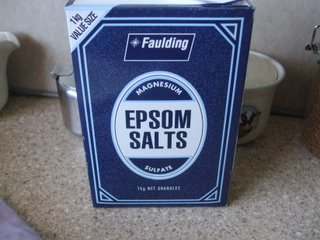
Many years ago when my interest in a more sustainable/self sufficient lifestyle was just starting I was reading about making salt from seawater. The book said that the easiest way was to boil up the sea water until salt crystals were left in the bottom of the container, but this method left impurities in the salt referred to as the “bittern salts” which gave the sea salt a (predictably enough) bitter flavour. This was where the book left it, with no hints on how to extract the bittern salts to get decent tasting salt, so I filed that information away in the back of my mind and carried on.
Sometime after that I was reading up about tofu and found the process for making nigari. First make sea salt by the boil down method then put the salt crystals into a hessian bag and suspend it over a trough or pot in a humid atmosphere, like by the sea somewhere! The nigari is exceptionally water soluble and it absorbs moisture from the air to the point where it becomes liquid, dripping into the vessel placed underneath the bag of salt. The water can be boiled off giving nigari crystals. So there you have it, the Japanese not only worked out a way to extract the impurities from their salt but but found out an important use for the impurity, amazing!
You can start the process off as soon as you have extracted the soy milk, or you can put the soy milk in the fridge and do it up to a week later. I find that the soy milk will keep for up to 10 days in the fridge. If you are using fridged soy milk you will need to reheat it to simmer for five minutes, removing it form the heat once this is accomplished.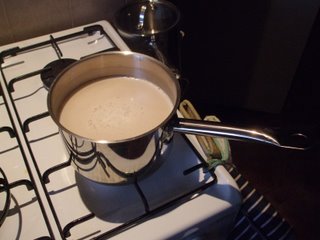
To coagulate the soy milk resulting from our one cup of dry soy beans add half a teaspoon of dry coagulant (nigari or Epsom salts) dissolved into half a cup of water. The plaster of Paris is not water soluble, but a similar amount will need to be slurried with water before addition to the soy milk. Pour the liquid coagulant over the top of the hot soy milk, one third of the volume at a time and mix it gently though the soy milk, then cover and let stand for 10 to 15 minutes to finish coagulating.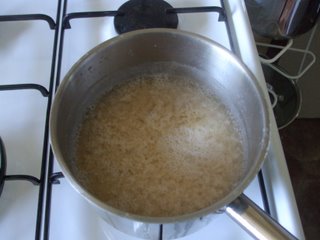
What you wind up with is a soft white curd floating in a yellowish whey. The next step is to filter the curds and press them into tofu. You can retain the whey and use it in bread making of as soup stock. To filter out the curds I press my faithful and long suffering pillowcase into service again and use it to line a white Tupperware strainer (I’m sure that 80% of the Australian population have one tucked away in a cupboard some where.) I then pour the curds and whey thought the pillowcase/strainer assembly (any decent size strainer or colander will do the trick really) and let the whey drip through. If i am feeling particularly frugal I will catch it and use it in cooking but most times it winds up down the sink.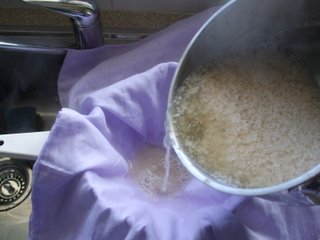
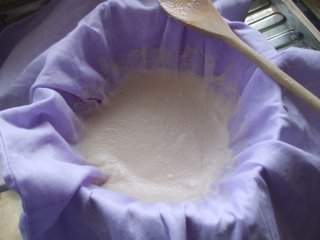
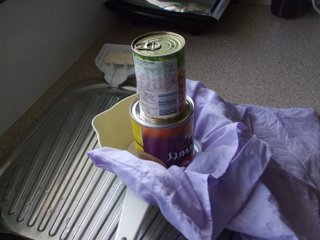
One point on the coagulator. I realise that Epsom salts do have other medicinal uses and have been used in the past to free up sluggish bowels, but the amount used here is very small and I think most of it remains in the water phase (the whey). In any case, I hve not suffered any ill effects from using it.
What you do next depends on how firm you like your tofu – I like mine firm so it holds together when I stir or deep fry it. What I do is fold the pillowcase over the top of the tofu and place a small plate or saucer on top, then place an 800gm and a 425 gram tin on top of the saucer to act as weights to press the tofu. I leave that there overnight and the result is very firm tofu. The next morning you just remove the weights and the saucer, unfold the pillowcase and there it is. Wash off any fluffy bits of pillowcase left behind and put the tofu in a container covered with water and store it in the fridge until you want to use it. It will last a week or two if you change the water every few days.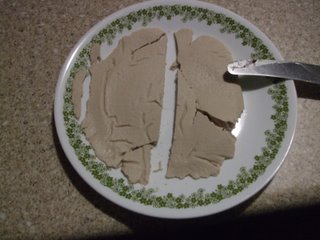
Now that you have made your tofu you can stir fry it with veggies, noodles, meaty bits or whatever and marinated in your favourite sauce or the sauce added after it is cooked. It can be deep fried until it is golden brown , then eaten by itself or added to other dishes. It can be added to Japanese or Chinese style soups or used as an ingredient in a Chinese firepot dinner. It can even be cut into slabs and put on the barbeque to make Aussie style tofu, which might shake up your guests a bit, or even convert them over to a new taste. Tofu, because of its subtle (or dare I use that word again – bland) flavour and its ability to take on the flavours of other foods it is very versatile. I recommend scanning the Asian cookbooks in your local library and copying down any promising recipes.
So you can see that to make tofu is not all that complicated and is certainly no more work than pasta making or baking your own bread. It is a lot of fun and you get a nutritious foodstuff at the end. Tofu can be an important source of protein, particularly if you follow a vegetarian or vegan lifestyle. It is also high in calcium. Or it can just be a change, something new and tasty to add to the family’s diet.



